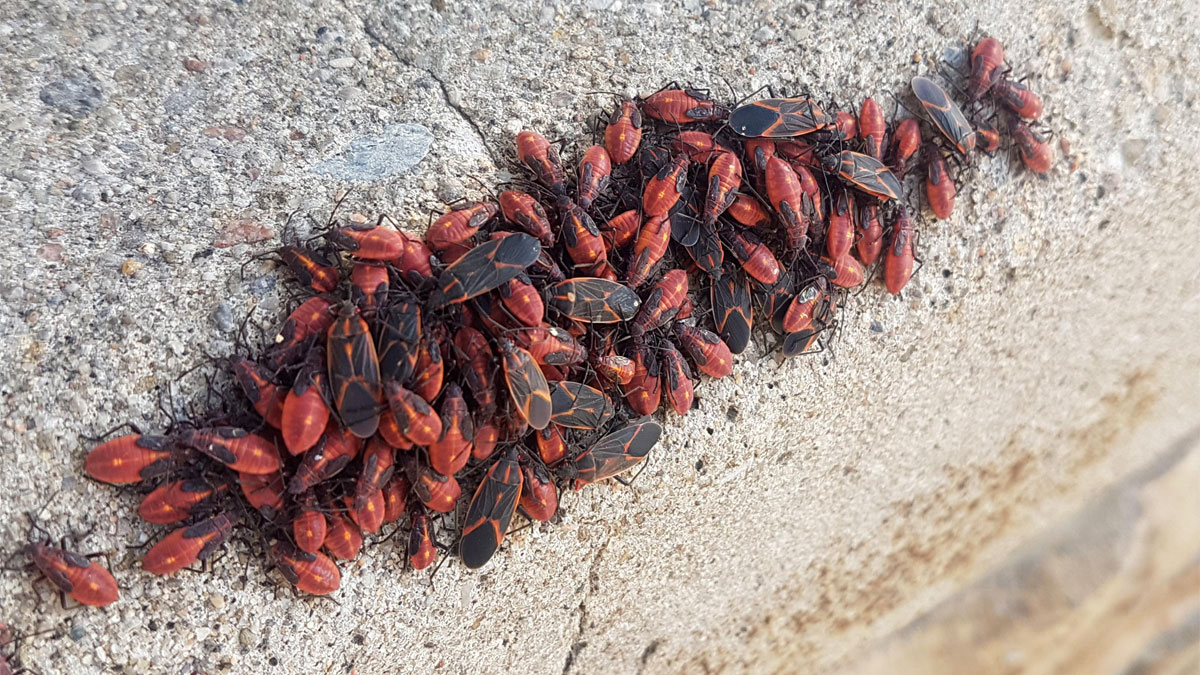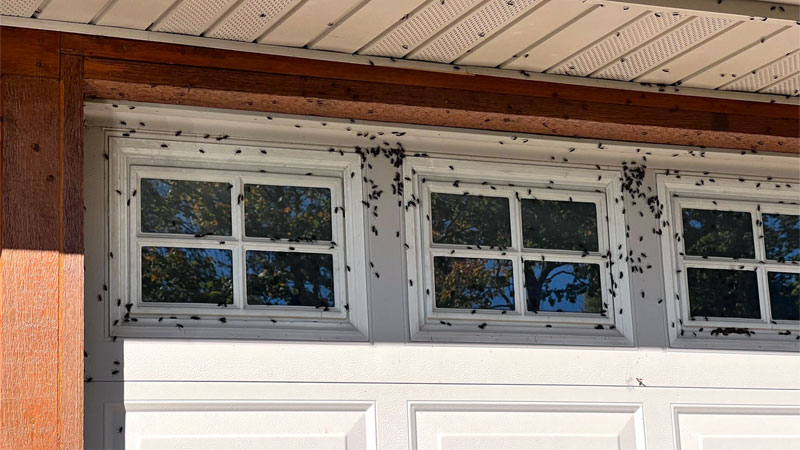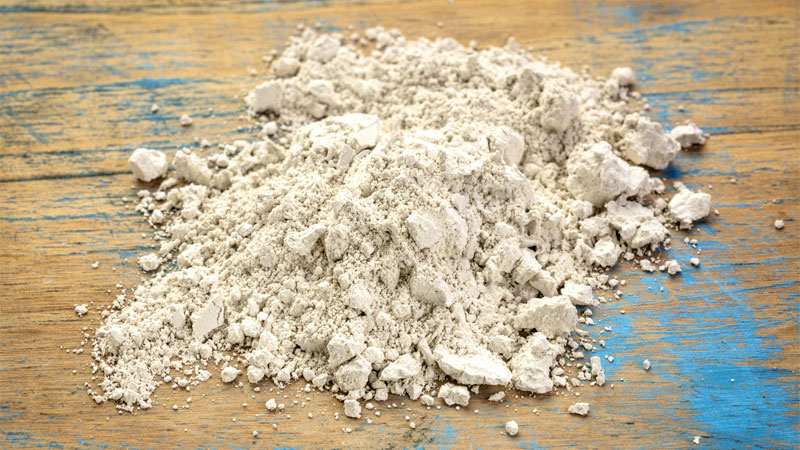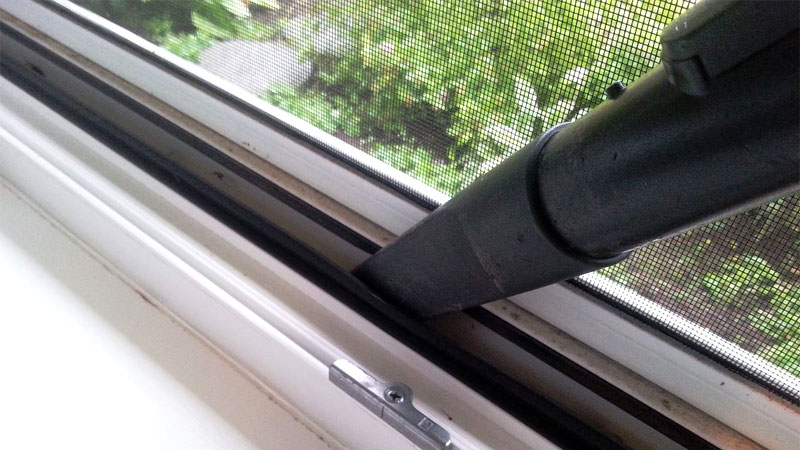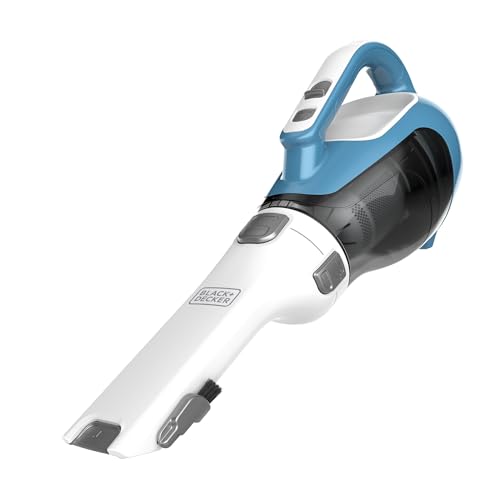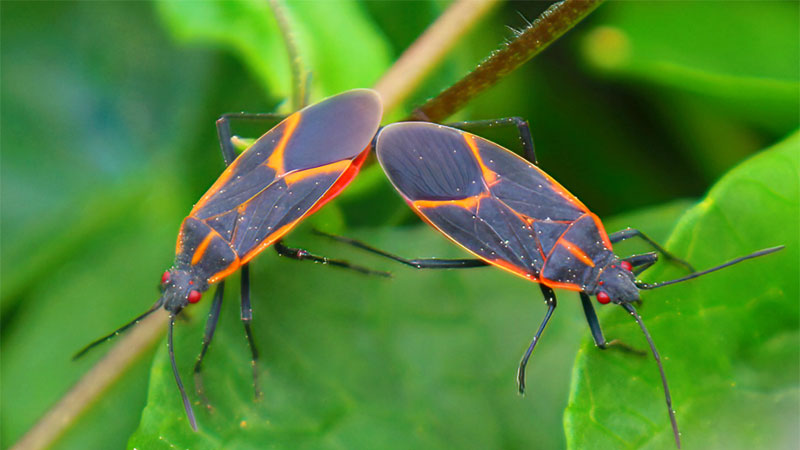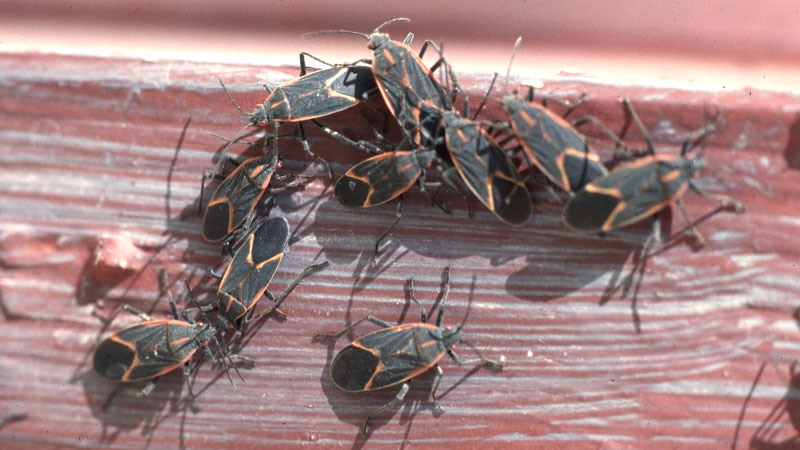Here are RMC, our members sometimes get called to deal with beneficial insects that have become nuisances. One perfect example of this is the boxelder (sometimes spelled box elder) bug. While harmless, these bugs can congregate on your walls or car, leaving a mess behind.
Here’s what you need to know to get rid of these critters. After, we’ll tell you how to identify these bugs, as well as how to keep them away.
Getting Rid of Boxelder Bugs
Box elder bugs are easy to get rid of, although there are a few things you may want to consider.
Considerations Before Box Elder Bug Treatment
For example, squishing them indoors can leave stains behind. They will also emit a rather nasty odor that might take a while to dissipate. Of course, they can also release this odor if disturbed, but it won’t be nearly as bad.
Another consideration is that getting rid of boxelder bugs may not prevent them from coming back the following year, so it’s more about controlling the size and location of these bugs than actually removing them permanently.
Finally, don’t kill them inside of wall cavities, as this can attract more problematic bugs such as carpet beetles and larder beetles. Instead, wait for them to wander out of the cavities and deal with them then.
Diatomaceous Earth: Nature’s Natural Killer
There are few insect killers as effective as food-grade diatomaceous earth (or DE, for short). This powdery substance is actually made from the microscopic crushed shells of fossilized diatoms. While harmless to humans and pets, on a bug’s scale, a surface sprinkled with DE is like walking across a field of broken glass.
The sharp edges lacerate any part of the bug coming in contact with it, scraping away the protective waxy coating and causing the bug to start leaking bodily fluids. Within a few hours to days (depending on the critter’s size), the unlucky bug will die of dehydration.
- Natural Product - Composed of 2lbs of pure ground freshwater diatomaceous earth...
- OMRI Listed - Listed with the Organic Minerals Research Institute, a non-profit...
- Supports a Great Cause - Harris donates 10% of profits to support the local...
Borax
Borax is a common household chemical that can be used in place of DE. This substance is often used for washing clothes and was added into milk in the 1800s to hide signs of spoiling. Unfortunately they discovered the harmful effects it was having on babies only after countless were permanently harmed.
Unlike DE, borax doesn’t kill the bug by cutting into it. Instead, it sticks to the bug’s legs and gets ingested as they groom. It then eats away at them from the inside.
- Add 20 Mule Team All Natural Borax Laundry Detergent Booster to laundry to help...
- Use 20 Mule Team All Natural Multi-Purpose Household Cleaner to wipe on counters...
- This 20 Mule Team all-purpose household cleaner removes soap scum, hard water...
You can sprinkle both of these remedies on just about any horizontal surface, but be sure to keep borax out of reach from curious hands or paws. You will also need to reapply every few days, as well as after it rains.
Does Neem Oil Kill Boxelder Bugs?
Thankfully, this natural extract can kill box elder bugs on contact. Neem oil is one of the greatest natural allies to plant lovers. While you have to be careful using it near aquatic life, this extract can be perfectly safe around beneficial insects when used properly.
It’s also non-toxic to humans and pets (just don’t guzzle it). best of all, it can be applied on crop plants as soon as 24 hours before harvest.
However, neem can also be a stealthy killer when used as a soil soak. You can use this treatment even on trees, where it will protect the plant from piercing or chewing insects (and even some fungi and bacteria) for up to 22 days.
When using neem oil for boxelder bugs, try spraying them with a solution of two tablespoons per gallon of emulsified (just add a teaspoon of dish soap) water.
- 🌿【The PUREST Neem Oil on the Market!】- Plantonix Neem Bliss is freshly...
- 🌸【Super Concentrated Neem Oil】- Unlike other brands, our neem oil spray...
- 🌱【Organic Neem Seed Oil】- Neem Bliss is listed by the Organic Materials...
Does Soapy Water Kill Boxelder Bugs?
This can be a slow process, but soapy water can be used to suffocate boxelder bugs both inside and outside the home. Simply take a spray bottle and mix in a tablespoon or so of Dawn dish soap or insecticidal soap.
Whenever you spot a boxelder bug, use the soapy water spray to completely coat it. The soap will clog their airways, although you probably don’t want to sit there waiting for them to die as it can easily take several hours.
Stick ‘Em With Sticky Traps
Sticky traps are available in a wide range of shapes and sizes, from cardboard glue traps to the infamous fly strip. As with any other bug, a boxelder bug will get stuck to the trap and slowly die.
Depending on the trap, you can use them indoors or even outdoors. They’re especially good for handling an invasion into your basement, garage, or shed. Just be sure to dispose of the traps when you’ve made a couple catches to minimize the risk of nasty odors.
- READY TO USE: Spider, Rodent and Insect glue traps are pre-scented and are...
- YEAR ROUND PROTECTION: Catchmaster glue traps are safe, non-toxic and no-mess....
- SAFE FOR THE FAMILY: Designed to help you keep your family protected and safe...
Use Some Spider-Sense
Most critters won’t go near boxelder bugs because of the nasty smell and taste. However, spiders aren’t so timid. While not able to eliminate large groups of boxelder bugs, having some spiders in your yard (or even home) can help keep smaller populations from getting out of hand.
Vacuum or Steam Them Away
One of the most effective weapons in your home arsenal is the humble vacuum cleaner. This wonderful tool can suck up boxelder bugs, carpet beetles, and a whole host of other unwanted critters. Even better, the vacuum won’t crush the bugs, so you can safely discard the canister contents or bag without the risk of staining.
While a full size vacuum will work, having a cordless handheld like a Black+Decker is a huge time saver. It also works great to suck up unwanted spiders and other critters that made their way into your home.
- MULTI-SURFACE USE – Removes hair, dirt, and debris from carpets, car...
- LIGHTWEIGHT AND PORTABLE – Easy to carry and maneuver, even in tight spaces.
- ERGONOMIC DESIGN – On-board extension means you won’t need to bend over as...
Additionally, you can use a steam cleaner to ensure the bugs are killed as well as cleaned. For the water to be effective, it must reach a temperature range of at least 160 to 180 degrees. Using a commercial steam cleaner can allow you to achieve even hotter temperatures.
This can be a great method because it will not only cook the bugs, it can also help remove some of the poop stains they might have left behind.
Getting to Know Boxelder Bugs
We cover a lot of common (and not so common) pests here at RMC, but sometimes there’s a critter that blurs the line. For example, crane flies might look like mosquitoes, but they’re actually beneficial predators. Bumble bees are incredibly important, but a lot of people have allergies. Cats are some of the most beloved pets, but stray cats can be a nightmare.
The box elder bug is another great line-blurring critter. While agriculturally harmless, their habit of congregating to sun themselves and unintentionally invading homes means they’re often considered a pest throughout their native range.
Sometimes mistakenly called stink bugs (due to the foul odor they release if handled), boxelder bugs actually come from the Rhopalidae family, which are ironicallty known as the scentless plant bugs. These curious insects have an attractive appearance. However, they’re generally not so attractive when they enter your homes.
What Does a Boxelder Bug Look Like?
Measuring just over ½ inches long, the oval-shaped boxelder bug (Boisea trivittata) is brown to black with distinctive bright red wing veins, as well as red markings on their abdomens.
The adult western boxelder bug (Boisea rubrolineata) is identical except for the red veins of its wings being visible on its corium (the upper part of the forewings).
The eggs are tiny and yellow, found in clusters that slowly redden as they mature. The emerging box elder bug nymphs are bright red and lack wings.
Where Do Boxelder Bugs Live?
The western boxelder bug is native to the western US. Meanwhile, the boxelder bug (sometimes referred to as the eastern boxelder bug) is native throughout the US with the exception of California.
They commonly overwinter underneath loose bark or leaf debris. However, they’re also known to hide behind siding where they can invade homes once the heating comes on.
Boxelder Bug Life Cycle
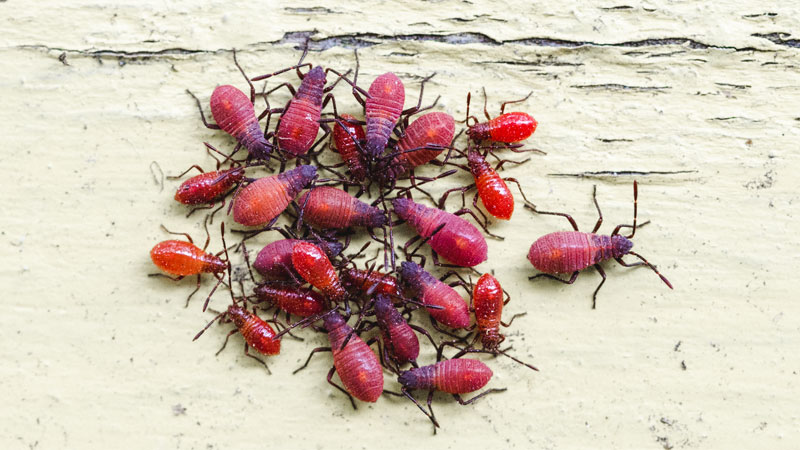
Box elder bugs are an overwintering insect that will emerge from their shelters in spring as the weather becomes warmer. Initially, they’ll stay closer to the ground, foraging for maple or ash seeds. After about two weeks, they’ll begin mating, which signals the end of their year-long lifespan.
The females will lay their eggs on female boxelder trees, preferring seed pods and the undersides of leaves. They’re also known to lay them along branches in a pinch.
After 10 to 14 days, the eggs will hatch into nymphs that will go through five stages to reach adulthood. Both the nymphs and adults remain in the trees throughout the summer. Only as the fall temperatures begin to drop will they emerge seeking out warm surfaces in hopes of locating viable shelter.
While there may still be nymphs this late in the year, only those boxelder bugs who have reached adulthood are able to survive the winter in whatever shelter they’ve managed to find.
What Do Boxelder Bugs Eat?
While boxelder bugs get their name from the boxelder maple (Acer negundo), they’ll readily feed on the immature seeds of any ash or maple tree.
As the trees begin to produce new leaves, they’ll often migrate into the trees and suck the juices from the young foliage. This can result in a bit of discoloration to the leaves, but no major damage.
While rare, they have also been known to cause damage to the fruits of apple, grape, peach, plum, and strawberry plants when seeking a place to overwinter.
When Are Boxelder Bugs Most Active?
You’re most likely to spot these critters in the warmer months sunning themselves in groups. However, as fall approaches, they’re known to congregate on the southern sides of buildings looking for warmth.
This can easily lead to them invading your home if they find an entry point.
What Attracts Boxelder Bugs?
Boxelder bugs are mainly attracted to their primary food source: ash and maple trees, particularly the boxelder maple. When these trees are scarce, they have been known to settle for apple or plum trees.
However, they are also attracted to warm, sunny spots such as rocks and south-facing building exteriors. You’ll often find them at these spots in large groups sunning themselves.
When a boxelder bug finds a nice spot, they’ll release pheromones to alert other nearby boxelder bugs of the find. This can soon result in a large swarm congregating in that area.
Why Are There Boxelder Bugs In My Home?
As with many insects, boxelder bugs don’t intentionally try to make a home in your home. The problem begins as fall approaches and the bugs begin to flock towards the warm southern-facing walls of your home or other structures to absorb the heat radiating out.
During this time, they’ll make use of entry points to find some winter shelter. In many cases, you won’t even know they’re there.
The real problem occurs once the heating kicks on. The warmth awakens the boxelder bugs, who are fooled into thinking it’s spring. The confused bugs will then follow the heat source, ending up inside the living areas of your home.
One there, their feces can leave red stains and attempts to handle or crush them will result in a nasty odor being released. In some cases, their carcasses can also accumulate inside wall hollows or other difficult to access areas.
Are Boxelder Bugs Harmful to Plants?
Boxelder bugs aren’t considered an agricultural pest. Any damage they do to fruits or other parts of maple and ash trees is very minor. Damaged fruit may appear dimpled or scarred, with extreme cases resulting in some deformation, hardened tissue, or a mild case of fruit drop.
However, this damage tends to be rare and doesn’t provide any significant crop loss. They aren’t known to attack ornamental plants at all.
Are Boxelder Bugs Harmful to Pets?
Boxelder bugs are perfectly harmless to your pets, although they might claim otherwise after an encounter. Handling the boxelder bug may result in a jab from their proboscis, and eating one will leave a taste in your pet’s mouth they won’t soon forget.
Your pet may also suffer a few side effects such as diarrhea, drooling, upset stomach, or vomiting, but these are minor and will clear up in a few hours.
Do Boxelder Bugs Bite?
Well, yes and no. Boxelder bugs are piercing insects, much like mosquitoes or aphids. They therefore lack the necessary mouthparts to bite.
However, when handled, they will sometimes pierce skin with their proboscis, which can leave a red, slightly itchy spot similar to a mosquito bite.
Preventing Boxelder Bugs In Your Home
If anyone ever tells you they know how to get rid of boxelder bugs permanently, ask them if they also have a bridge you can buy. Simply put, you can control the outdoor population, but can never eliminate it entirely. So instead, let’s focus on keeping them out of your home.
Keeping boxelder bugs away is a two-step process that is easier if you’re only worried about the first step. Let’s go over both together, including some extreme measures that might be necessary for the best results.
Keeping Boxelder Bugs Out of Your Home (Garage, Shed, etc.)
Boxelder bugs can get into some pretty small spaces. In fact, they can find their way into openings as small as .07 inches around. You should make it a habit to check your windows and doors twice per year to ensure the frames are properly caulked and there’s no damage to the screens.
It’s also a good idea to carefully check the exterior of your home for possible entry points, such as gaps around wires or pipes entering the house and seal these.
Finally, you can hire an independent contractor to perform a smoke test, which will reveal any leaks in the walls. This is not only helpful for blocking pests, it can really save on your HVAC bills.
Keeping Boxelder Bugs Off of Your Property
Now for the hard part – making sure these critters stay away from your property. There are several things you can do to keep visiting numbers low. However, not all of them are appealing and none are 100 percent effective.
Bug Blasting
When boxelder bugs find a good spot to sun themselves or take shelter, they’ll release a scent that attracts others. You can prevent this by taking a garden hose or a spray bottle with a strong stream and knocking them away when you suspect they’re planning to gather.
While it won’t kill them or drive them away, it can force them to look for a different spot and prevent them from calling out to the others.
You can make the bugs feel even less welcome if you make an equal mix of white vinegar and water. They don’t like the smell of vinegar and will be even more reluctant to return to that spot. Not to mention, the vinegar cancels out any hormone signals the boxelder bugs had already released.
Remove Food Debris
The first step is to grab the rake and do some fall maintenance. If you have a maple or ash tree, try to rake up any fallen leaves or seeds frequently throughout the autumn months.
This not only denies boxelder bugs some potential overwintering shelter, it also removes their primary food source.
Remove the Trees
The most extreme remedy is to remove all female maple or ash trees from your property. The male trees won’t produce seeds and thus shouldn’t pose a problem. Obviously, this is a last resort, and hiring a professional tree removal service isn’t cheap.
But if you’re at your wit’s end and in an area where these trees are very common, this might be the only way to discourage this critter from visiting your property.
Use Horticultural Oils
You can treat your trees with horticultural oil to help evict boxelder bugs. Bonide brand works well, as does the aforementioned neem oil. The timing is critical, as you will want to treat the trees after the boxelder bugs have begun to emerge but before the trees exit the budding stage and begin producing blooms.
Be sure to coat the tree thoroughly, getting under any loose bark where the bugs like to hide.
- How to Get Rid of Hawks - March 8, 2024
- How to Get Rid of Pill Bugs (Rolly Pollies) - March 1, 2024
- How to Get Rid of Groundhogs (Woodchucks) - February 5, 2024

